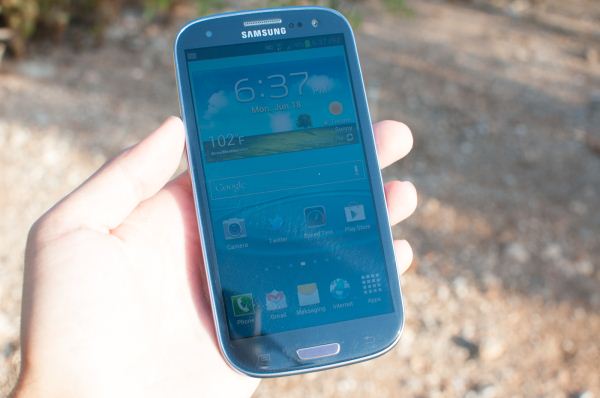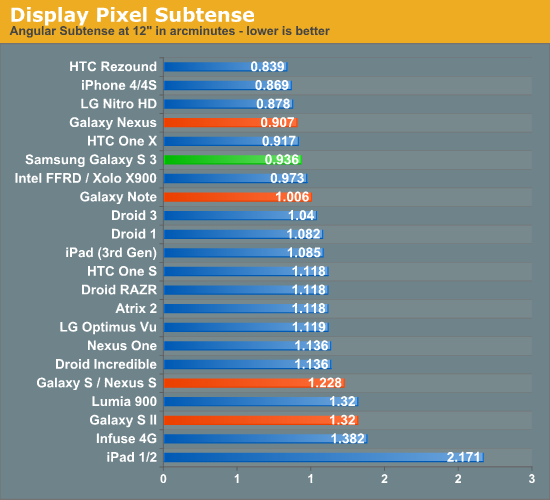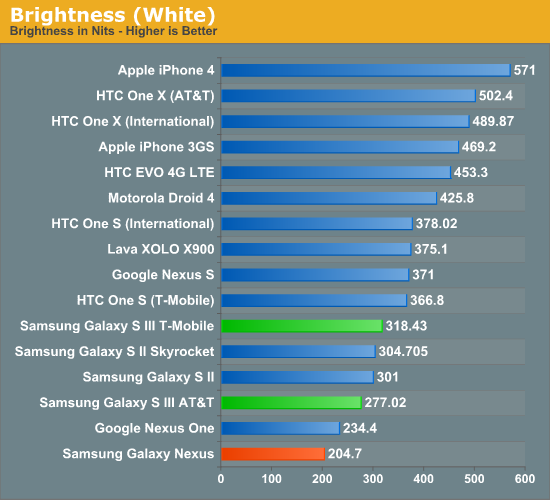Samsung Galaxy S III Review - AT&T and T-Mobile USA Variants
by Brian Klug on June 20, 2012 12:01 AM ESTOne of the standout features on the SGS3 is the 4.8" HD SAMOLED display, which has an effective resolution of 1280x720. Like other Samsung devices, the name tells you almost everything you need to know: HD connotes 720p, S for Super means the stack is optically bonded with fewer air gaps (and thus fewer fresnel 4% back reflections), and the lack of Plus means it’s an RGBG PenTIle subpixel matrix.
First off, it’s clear to me that the SGS3 display is a substantial improvement on the Galaxy Nexus display, which was 4.65" diagonal and also 720p HD SAMOLED. The problems that I talked about in the Galaxy Nexus display are basically completely absent in the SGS3. There’s no longer any mura (luminance variance which looks like noise) or a weird purple cast in the greys, two things that are still present on the Galaxy Nexus. I suspect that moving to a larger display with the same resolution (and thus larger subpixels) might have helped mitigate some of the mura, and in addition this appears to be a completely new revision of the process with none of those problems.

Outdoor viewing angles are pretty darn good
I think it’s also worth discussing PenTile once more - specifically in the context of whether or not you can see the pixels. At this point, I don’t think we need to go over what it is in much detail, but that it uses two sets of two subpixel units to achieve higher effective resolution than an RGB stripe. There are two variants - RG, BW which I’ve seen in a few Motorola LCD displays (that are Samsung), and RG, BG, which is the more common variant that is in all the AMOLED panels without the “plus” suffix.
The implementations that I complained loudest about were really the Nexus One and Nexus S / Galaxy S, where AMOLED was still somewhat in its infancy, and RG, BG was both a way to increase subpixel lifetime before fading took place (according to Samsung), and achieve a higher logical resolution with fewer subpixels than an RGB stripe would require. For that reason, you can’t really just evaluate a display with some boolean is garbage / not garbage based on the presence of PenTile alone. In theory, if the logical two-pixel cell is itself smaller than human visual acuity, then you shouldn’t be able to see it, and seeing the pixels is what drove me crazy about those two phones.
I present the following graph, which has the angular subtense in arcminutes along the stripe (when a device is held portrait, this is the x direction) of one logical pixel. That is to say, two subpixels if we’re talking about an RGBG PenTIle display, or three for an RGB display. For reference, human visual acuity is most often cited as being around 1 arcminute for the human vision system corrected to 20/20, which isn’t perfect vision (20/15 or slightly better is). Anything below that should be indistinguishable at a distance of 12 inches (standard viewing distance).

This is what I’m talking about when I say that in implementations such as the SGS3, even though PenTile is present, the logical pixel is still smaller than visual acuity, and the subpixels are half that. There’s still a case to be made for whether you can see fringing on black text on a white background to some extent, but personally I cannot see it.
So how is the display in other terms, such as brightness, color rendering, and viewing angles? For this I turned to the combination of my display colorimeter (still an i1D2), ColorHCFR, and Francois’s excellent Voodoo Screen Test Patterns.
When it comes to brightness, I found that oddly enough the T-Mobile and AT&T devices differed by a measurable and repeatable margin. Possibly these are from completely different batches, possibly there is some optimization done for the display brightness dynamic range to conserve battery - I’m not sure. Either way, it’s there, but the SGS3 is thankfully brighter than the Galaxy Nexus, though it still seems to be clamped to a fairly conservative number.

I measured blacks a few times and tried to see if I could get a reading on whether the SGS3 also has a slight DC bias (not fully off), but still couldn’t get anything. If it’s there, I haven’t noticed it yet.
In the Color HCFR testing, we can see that gamma looks very weird and nonlinear across the greys, going from around 2.4 down to 1.2, I have no idea what’s going on here. Color temp is thankfully a bit more controlled, at just under 7000K, and relatively flat.

I measured both devices after seeing that there was variance, and uploaded the color.chc files for both the AT&T and T-Mobile model for people with HCFR installed to check out. I’ve also made two galleries for the respective panels. I’ve heard really good things about the International SGS3 from Francois (supercurio), but haven’t measured it yet. I guess these initial numbers make me suspect that like SGS2 the USA variants have differences in the display rendering. I will say that over a range of brightnesses the SGS3 seems to have much less of the color shift compared to other AMOLEDs I’ve seen in the past.























107 Comments
View All Comments
ervinshiznit - Wednesday, June 20, 2012 - link
On your SGSII review you say that it had 17 Mbps 1080p video recording, not 15 Mbps as you state in this article.Brian Klug - Wednesday, June 20, 2012 - link
Oh weird, I didn't go look at what I wrote before but went off of what I heard at some point from a Samsung rep said. Fixing...-Brian
vol7ron - Wednesday, June 20, 2012 - link
3rd paragrah threw me off.. "I was sampled"vol7ron - Wednesday, June 20, 2012 - link
err 4thZoomer - Wednesday, June 20, 2012 - link
Do you have any insight on why Samsung chose not to go with a pentaband design like with the SGN? Personally, that's a bit of a deal breaker.Brian Klug - Wednesday, June 20, 2012 - link
The T-Mobile variant is pretty close, it's just missing 900 MHz WCDMA (eg GN is 850, 900, 1700, 1900, 2100 MHz, T-Mo SGS3 is 850, 1700, 1900, 2100). Other than that, the device will work on AT&T and T-Mo, if you can snag an unlocked one.Or are you talking about GT-I9300 (the canonical SGS3)?
-Brian
3DoubleD - Wednesday, June 20, 2012 - link
Can you name the models in the review using their model number. You say SGSIII USA, but there are 4 models total and 3 of those are being carried in the US. Calling it T999, I747, I535, and I9300 is much more straightforward and avoids a lot of confusion. Also, if Samsung doesn't want to be embarassed by their terrible naming, they can pick better model names.Thanks for the speedy review. I didn't expect this review for at least a few more weeks. Thanks a million!
Brian Klug - Monday, June 25, 2012 - link
Sure:AT&T: SGH-I747
T-Mobile: SGH-T999
-Brian
Zoomer - Wednesday, June 20, 2012 - link
Are you certain that it supports Band I when it's doing AWS? It seems to be a common theme among other phones.sunbear - Saturday, June 30, 2012 - link
If I can unlock a tmobile device, would it work on AT&T's LTE, or would it be limited to to HSPA+?